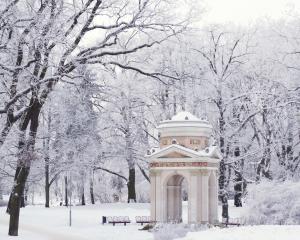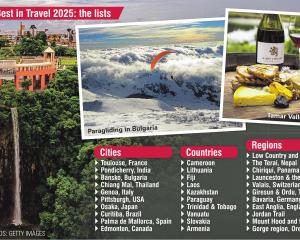Starting the trail from the Kawarau Historic Reserve, ample parking is available in what is commonly referred to as the "bungy car park".
The starting point of the trail is marked by two large stones, donated by one of the trail's 10 private landowners, Henry Van Asch, in 2008.
The first stretch of trail passes through an archaeological site which Ms Stevens says was unexpectedly bulldozed before the trail work began.
"Along the trail, it has always been a priority to not add any further destruction.
Where we had to, we have used other means to ensure there is no destruction to any of our heritage," she says.
Further into the trail, the scene looking back towards the Kawarau Historic Reserve presents a starkly contrasting view of the Judge and Jury rock formation high above the Kawarau suspension bridge, and the more contemporary, Van Asch-owned winery, The Winehouse and Kitchen.
Ms Stevens says the trail's interaction with Gibbston wineries and restaurants is a big part of the overall trail experience.
"Gibbston is famous for its rich wine history and being able to combine that with such a beautiful trail makes for a more Gibbston experience," she says.
Most of the trail will be maintained by the Department of Conservation.
However, the first stretch of trail, before reaching the Wentworth Bridge Loop, will be the responsibility of Gibbston Valley Station (GVS).
Plans for the $300 million GVS development project began in 2006, and resource consent was first sought in 2008.
The proposed project, said to be in the preliminary stages, will encompass more than 62 visitor accommodation units and a full 18-hole golf course planned to tie in with the Gibbston River Trail.
Nearing the end of this section, trail users will see the first of the trail's many concrete survey pillars.
The pillars were set up in the early 1980s to monitor landslide movement when hydro-electric schemes were proposed for the Kawarau Gorge.
The schemes were abandoned because of slope instability, but a number of the cylindrical blocks still stand.
The Wentworth Bridge Loop
Centrally located, the 2.7km Wentworth Bridge Loop is what Ms Stevens calls the most picturesque and most historical stretch of the full Gibbston River Trail.
Earlier this year, 12 timber bridges were lowered on to the trail by helicopter.
Eleven of these bridges are used on the Wentworth Loop to provide access, and to protect the abundance of historical mining sites.
Trail users will be able to access the bridge loop from an intersection.
Ms Stevens says directional signs, still to be put in place, will indicate two alternate pathways.
She says the pathway to the Wentworth Bridge Loop, towards the Kawarau River, will be marked as the "scenic" option, and will be an "absolute must" for trail users.
"Walking an extra 25 metres or so to access the Wentworth Loop is something every trail user should do," she says.
The other pathway, which runs towards the Peregrine Wines car park, is wider and more suitable for cyclists.
"We are recommending cyclists stay off the Wentworth Loop ... you can imagine if someone grows tired, or if they aren't an experienced cyclist, things could get dangerous," she says.
Furthermore, Ms Stevens says she has always made efforts to ensure the majority of the trail is wheelchair- and pram-friendly, and only a handful of sections may be inaccessible.
Once on the loop, a glance over the side of the first two bridges will reveal surprisingly well preserved stacked-stone mining piles, and the remnants of old mining tunnels.
Further along, the higher bridges provide the trail user with a full panoramic vista, offering idyllic views in all directions.
Once trail users turn towards the west, they will see the Kawarau River meandering through an assortment of natural features, such as the Bridal Veil Falls and acres of dense native vegetation.
Back east, the river forms into lively dog-leg rapids which are lost to the eye at the base of a mountainous horizon, capped by the looming peaks of the Nevis Bluff range.
One feature Ms Stevens is particularly proud of is a pathway of descending "switchbacks" halfway into the Wentworth Loop.
"It took days for the labourers to excavate the pathway through the rocky outcrop, and a lot of the work had to be done manually," she says.
Aside from intensive excavation works, Ms Stevens has drawn support from archaeological, ecological and mining experts.
She has received further assistance from Gibbston community members, eager volunteers and community probation service workers.
"The list of people involved is really endless, it's been a huge undertaking for everyone," she says.
Leaving the Wentworth Bridge Loop, the trail crosses two steel-truss bridges, which are longer and much higher than the other 12 timber bridges.
The final bridge was lowered into place by helicopter in October.
The view from the first bridge offers a corridor snapshot of the Kawarau River below, and is high enough to induce a mild case of vertigo.
The second bridge crosses over a tumbling river and brings the user to the final stretch of trail before arriving at the Peregrine Wines carpark.
Waitiri Loop
The Waitiri Loop can be found at the far end of the trail. Opened to the public in March 2007, the track provides views and access to the white shores of Big Beach and the clearest views of the Nevis Bluff.
Waitiri Creek winery manager Jason Thomson says the word waitiri means "turbulent waters" in Maori and was chosen to reflect the thundering Nevis Bluff rapids.
Ms Stevens says the original plan was to link the trail directly all the way from the Kawarau Historic Reserve to the Waitiri loop, but negotiations are still taking place with a private landowner to achieve this.
As a provisional measure, the track diverts out to the Gibbston Highway, bypassing the private land in the meantime.
Rum Currie's Hut and car park
In 2009, Ms Stevens won the New Zealand Archaeological Association Public Archaeology Award for her work on gold-mining heritage, the majority of which was in the Rum Currie area.
The site is home to a rare pre-1900 fruit orchard and rock huts left over from the goldrush.
While Rum Currie's hut was restored earlier, the remains of another hut and associated rock work were uncovered and mapped by Ms Stevens and her team.
Rum Currie's hut was originally created by rabbiters from stables built by one of the area's original settlers, Hughie Harvey, Ms Stevens says.
After Mr Harvey's death shortly after World War 1, two rabbiters converted his stables into a cosy hut.
Then during the Great Depression in the 1930s, the hut was taken over by Jack Currie.
Ms Stevens says the hut was later dubbed "Rum Currie's" as Currie was known for his drinking.
Of Mr Currie, historian Anne Cook writes: "In later years, his boozing often became indiscriminate ... nevertheless in better days, when he did some gold-mining and occasionally helped with the harvesting, he kept up a neat appearance and a tidy hut".
Ms Stevens says an archaeologist produced a "brick by brick" drawing to be used if there were any changes, or damage, to the hut.
She says interpretation panels would be placed at the site to "preserve the Gibbston narrative".
A community working bee was held in the area recently, with 273 native plants planted.
Providing a final stretch of landowner easement is secured, the Rum Currie area should be accessible from both ends of the trail, via Rafter's Rd.
However, if negotiations are not concluded in time, the track itself might come to an end at that point.
Future developments
Six years of hard work went into creating the Gibbston trail, which opened on Saturday and is expected to become a "beacon" drawing people to the Gibbston community - with benefits also for the wider lakes district.
Ms Stevens says the Queenstown Lakes District Council was making plans to extend the trail as far west as Arrowtown from 2012 onwards, and the project had also sparked interest in similar projects in towns down the Clutha River.
Ms Stevens said the trail itself had already attracted interest from commercial walking and cycling companies.
Doc predicts the Gibbston River Trail could attract more than 20,000 visitors a year - based on the experience of other trails.
Over the past six years, Ms Stevens has worked full-time and devoted all her energies to make the trail a reality.
She has experienced peaks and troughs - from exhaustion to satisfaction - and for the past month has turned in 15-hour days to make sure the track was ready.












